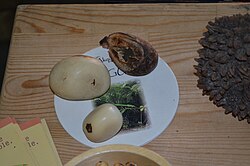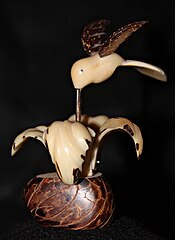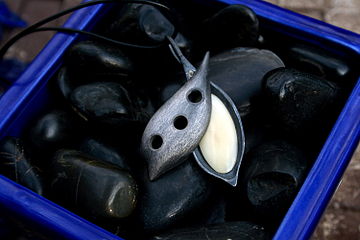Phytelephas
| Phytelephas | |
|---|---|
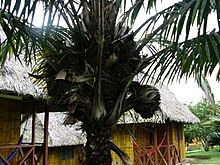
| |
| Fruiting tagua palm (Phytelephas aequatorialis) | |
| Scientific classification | |
| Kingdom: | Plantae |
| Clade: | Tracheophytes |
| Clade: | Angiosperms |
| Clade: | Monocots |
| Clade: | Commelinids |
| Order: | Arecales |
| Family: | Arecaceae |
| Subfamily: | Ceroxyloideae |
| Tribe: | Phytelepheae |
| Genus: | Phytelephas Ruiz&Pav. |
| Species[1] | |
| Synonyms[2] | |
Phytelephasis agenuscontaining six knownspeciesofdioecious[3]palms(familyArecaceae), occurring from southernPanamaalong theAndestoEcuador,Bolivia,Colombia,northwesternBrazil,andPeru.[2][4]They are commonly known asivory palms,ivory-nut palmsortagua palms(/ˈtɑːɡwə,ˈtæɡ-/); thescientific namePhytelephasmeans "plantivory"or more literally," plant elephant ". This and the first two of the common names refer to the very hard whiteendospermof their seeds (tagua nutsorjarina seeds), which resembleselephant ivory.[5][6]
Description
[edit]They are medium-sized to tall palms reaching up to 20 m tall, with pinnateleaves.The "nut" is covered withpericarp,which gets removed by animals. The kernel is covered with a brown, flaky skin and shaped like a smallavocado,roughly 4–8 cm in diameter. The male plants produce catkins up to three feet (0.9 meter) in length of male flowers, each bearing up to one thousandstamens,[7]the greatest number of anyMonocot.
Uses
[edit]Given trade restrictions inelephantivory as well asanimal welfareconcerns, ivory palmendospermis often used as a substitute for elephant ivory today, and traded under the namesvegetable ivory,palm ivory,marfil-vegetal,corozo,tagua,orjarina.When dried out, it can be carved just like elephant ivory; it is often used forbeads,buttons,figurines andjewelry,and can be dyed. More recently, palm ivory has been used in the production ofbagpipes.[5]
Vegetable ivory stimulates local economies in South America, provides an alternative to cutting downrainforestsfor farming, and prevents elephants from being killed for the ivory in their tusks.[5]
InEcuador,the Ecuadorean ivory palm (P. aequatorialis) is thespecieswhose kernels are widely harvested. The large-fruited ivory palm (P. macrocarpa) is the ivory palm native to Brazil, and most internationally traded palm ivory is derived from this species. The Colombian ivory palm (P. schottii) andP. tenuicaulis,both formerly included inP. macrocarpa,are the usual source of the product inColombia.The other two species are quite rare and have a restricted range; they are not used fortaguaproduction on a significant scale.[5]
The kernels are picked up from the ground after the ripe fruit has detached from the tree and forest animals have taken care of thepericarp,or harvested when ripe and the pericarp manually removed. As the nut shrinks when it hardens, a small hollow cavity can form in the center. It is often not possible to know whether the inside of the nut will have a small cavity in the center until it is cut into. Therefore, when carving, it is common to either incorporate the hole or cavity into carvings or not carve deep enough to reach a potential cavity.[5]
In their native range, these palms are also used as a source of food and construction wood.
-
Taguacarvings
-
Ecuadorianhandicraft
-
Silverlocketwithtaguacenter
List of species
[edit]The following species are recognized:[1]
| Image | Scientific name | Common Name | Distribution |
|---|---|---|---|
 |
Phytelephas aequatorialisSpruce | Ecuadorean ivory palm | Ecuador |
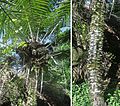 |
Phytelephas macrocarpaRuiz&Pav. | Large-fruited ivory palm | northwesternBrazil,Bolivia,Peru,Colombia |
| Phytelephas olsoniiR.W. Brown | Ecuador | ||
| Phytelephas schottiiH.Wendl. | Colombian ivory palm | Colombia | |
 |
Phytelephas seemanniiO.F.Cook | Colombia,Panama | |
 |
Phytelephas tenuicaulis(Barfod)A.J.Hend. | Colombia, Ecuador, Peru | |
| Phytelephas tumacanaO.F.Cook | Nariño Departmentof Colombia |
References
[edit]- ^abThe Plant List (2013). Version 1.1. Published on the Internet;http://www.theplantlist.org/tpl1.1/search?q=Phytelephas(accessed 11 September 2017).
- ^ab"World Checklist of Selected Plant Families: Royal Botanic Gardens, Kew".kew.org.
- ^Pülschen, L. (2000). "Biology and Use of Vegetable Ivory Palms (Phytelephas SPP.)".Acta Horticulturae(531): 219–222.doi:10.17660/ActaHortic.2000.531.35.
- ^Govaerts, R. & Dransfield, J. (2005). World Checklist of Palms: 1-223. The Board of Trustees of the Royal Botanic Gardens, Kew.
- ^abcdeVegetable ivory: saving elephants and the rain forest
- ^Bolongaro, Kait (2017-03-23)."How an obscure seed is helping to save the elephant".BBC News.Retrieved2017-03-27.
- ^Corner, Prof. E.J.H. (1966).The Natural History of Palms.Berkeley, Calif.: Univ. of Calif. Press. p. 147.

